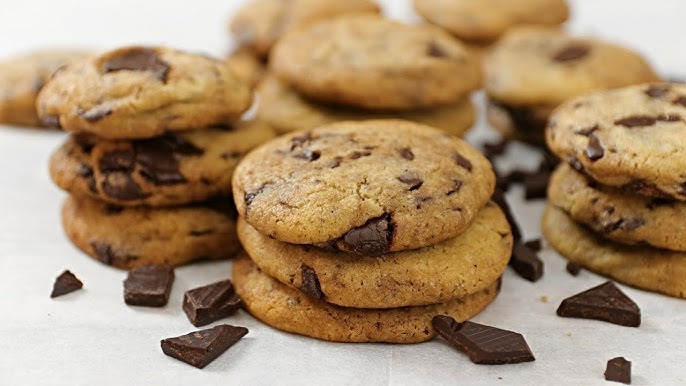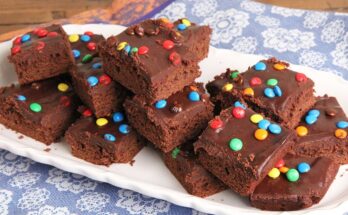Nestle Chocolate Cookie Recipe: Who can resist a batch of warm, gooey Nestle chocolate cookies straight out of the oven? They’re a classic comfort food that evokes memories of childhood, family gatherings, and lazy Sunday afternoons. Nestle’s original Toll House cookies have been a staple in kitchens for decades, winning hearts with their perfect balance of crisp edges and soft, chewy centers.
There’s something magical about baking cookies at home. It’s not just about the final product; it’s about the experience—the aroma filling your kitchen, the sense of achievement, and the joy of sharing something you made with love. And trust me, once you’ve tried making your own Nestle chocolate cookies, there’s no going back to store-bought!
Ingredients Needed
To bake the perfect Nestle chocolate cookies, you need the right ingredients. Here’s your shopping list:
- 2 1/4 cups all-purpose flour
- 1 teaspoon baking soda
- 1 teaspoon salt
- 1 cup (2 sticks) unsalted butter, softened
- 3/4 cup granulated sugar
- 3/4 cup packed brown sugar
- 1 teaspoon vanilla extract
- 2 large eggs
- 2 cups Nestle Toll House Semi-Sweet Chocolate Morsels
- 1 cup chopped nuts (optional)
Ingredient Tips:
- Butter: Use high-quality, unsalted butter and make sure it’s softened but not melted. Room temperature butter creams better with sugar, creating that desirable fluffy texture.
- Sugars: A mix of brown and white sugar gives cookies their caramel flavor and chewy texture.
- Flour: Always measure flour properly—spoon it into the measuring cup and level it off with a knife. Packing flour can lead to dense cookies.
- Chocolate Chips: Nestle Toll House semi-sweet morsels are the classic choice, but feel free to mix in milk chocolate or dark chocolate chips if you prefer.
- Eggs: Room temperature eggs blend more easily into the batter.
Having the right ingredients on hand is crucial. Skimping or substituting can completely change the texture and flavor of your cookies.
Tools and Equipment You’ll Need
Good tools make baking easier and more enjoyable. Here’s what you’ll need:
- Mixing Bowls: Large and medium-sized bowls
- Hand Mixer or Stand Mixer: For creaming butter and sugars
- Measuring Cups and Spoons: Precision matters in baking
- Whisk: To combine dry ingredients
- Spatula: For folding in chocolate chips and scraping the sides of the bowl
- Baking Sheet: Heavy-duty and light-colored for even baking
- Parchment Paper or Silicone Baking Mat: Prevents sticking
- Cooling Rack: Allows cookies to cool properly without becoming soggy
Optional but Helpful Tools:
- Cookie Scoop: For uniform cookie sizes
- Kitchen Scale: For accurate ingredient measurements
- Offset Spatula: Handy for lifting cookies off the baking sheet
Having the right tools will save you time and ensure better results. Investing in good equipment is totally worth it if you bake often.
How to Make Nestle Chocolate Cookie – Step by Step Guide
Step 1: Preheat Your Oven
Before you even touch the flour, get your oven ready. Preheating is a small step with a big impact.
Why Preheating Matters:
An oven that isn’t properly preheated can cause cookies to spread too much or bake unevenly. Consistent heat ensures the cookies set correctly from the moment they hit the baking sheet.
Recommended Temperature:
Set your oven to 375°F (190°C). This temperature helps create cookies that are golden on the outside while remaining soft and chewy inside.
Tips for Preheating:
- Always wait until the oven fully reaches the desired temperature before baking.
- Use an oven thermometer to ensure accuracy. Many ovens run hotter or cooler than their dial settings.
Skipping preheating is a rookie mistake that can ruin a batch of cookies. Make it a habit to preheat as soon as you start gathering your ingredients.
Step 2: Mix the Dry Ingredients
This step sets the foundation for your dough’s texture.
How to Mix Dry Ingredients Properly:
- In a medium-sized bowl, whisk together the flour, baking soda, and salt.
- Whisking instead of stirring distributes the leavening agent and salt more evenly.
Common Mistakes to Avoid:
- Skipping Sifting: While not always necessary, sifting can break up clumps and aerate the flour for lighter cookies.
- Incorrect Measurements: Always level off flour with a knife; too much flour can make cookies cakey instead of chewy.
Pro Tip: Mix the dry ingredients ahead of time and set them aside. That way, once you start working with wet ingredients, you can combine everything smoothly without delays.
Step 3: Cream the Butter and Sugars
Now comes one of the most important steps in cookie-making magic—creaming the butter and sugars together.
Why Creaming Is Essential:
Creaming isn’t just mixing; it’s about incorporating air into the butter, which gives cookies their light texture and helps them rise properly. When done right, it creates a smooth, fluffy mixture that forms the perfect base for the rest of your dough.
How to Cream Butter and Sugars:
- In a large mixing bowl, add the softened butter, granulated sugar, and brown sugar.
- Using a hand mixer or a stand mixer with a paddle attachment, beat the mixture on medium speed.
- Cream until the mixture looks light and fluffy—this should take about 3-5 minutes.
Pro Tips:
- Butter Temperature: The butter should be soft enough to press your finger into easily but not so soft that it’s greasy. Ideally, you should leave it out for about an hour before baking.
- Scraping the Bowl: Pause halfway through creaming to scrape down the sides of the bowl. This ensures everything mixes evenly.
Common Mistakes:
- Overbeating: Be careful not to overbeat once it’s fluffy; it can break down the mixture and affect the cookies’ structure.
- Cold Butter: If the butter is too cold, it won’t cream properly, leaving chunks in your dough.
Think of this step like building the foundation of a house—if you rush it or do it poorly, the final product just won’t be as good.
Step 4: Add Eggs and Vanilla Extract
Now that your butter and sugars are creamed, it’s time to add richness and flavor.
How to Add Eggs and Vanilla Properly:
- Crack the eggs into a small bowl first to make sure no shell gets into the dough.
- Add eggs one at a time into the creamed butter and sugar mixture.
- Beat well after each addition.
- Add the vanilla extract and mix until everything is fully incorporated.
Why This Step Matters:
- Eggs bind the ingredients together and add moisture.
- Vanilla brings that beautiful aromatic sweetness that makes cookies irresistible.
Tips for Success:
- Room Temperature Eggs: Just like butter, your eggs should be at room temperature. Cold eggs can cause the butter to seize up and lead to an uneven batter.
- Don’t Overmix: Once the eggs and vanilla are in, mix just until combined. Overmixing at this point can lead to tough cookies.
Adding eggs is like breathing life into your cookie dough. It transforms the gritty butter-sugar mixture into a silky, rich base ready for the dry ingredients.
Step 5: Combine Wet and Dry Ingredients
Here’s where it all starts coming together.
How to Combine Like a Pro:
- Gradually add the dry ingredients to the wet mixture.
- Mix on low speed (or stir by hand) just until the flour disappears.
- Scrape down the sides and the bottom of the bowl to ensure no pockets of flour are left.
Important Notes:
- Mixing Gradually: Dumping all the flour in at once can overwhelm your dough and cause flour to puff everywhere.
- Avoid Overmixing: Once you no longer see streaks of flour, stop mixing. Overmixing develops gluten, making cookies tough and bread-like.
Signs Your Dough Is Perfect:
- It should look thick and slightly sticky but not wet.
- It should hold together well without being overly dry.
Quick Troubleshooting:
- Too Dry: Add a splash of milk or a bit more vanilla if needed.
- Too Wet: Chill the dough for 20 minutes before baking.
Combining the wet and dry ingredients is like introducing two best friends—you want them to get along, but you don’t want to smother them!
Step 6: Add Nestle Chocolate Chips
Now, it’s time for the star of the show—Nestle chocolate chips!
Adding them correctly ensures that every bite of your cookie is loaded with melty, gooey goodness.
How to Fold in the Chocolate Chips:
- Once your dough is mixed and ready, gently fold in the Nestle Toll House Semi-Sweet Chocolate Morsels using a spatula.
- Stir just until the chips are evenly distributed throughout the dough.
Why Folding Matters:
- Aggressive mixing can crush the chocolate chips and mess up your cookie dough’s structure.
- Gentle folding keeps the dough tender and the chips intact.
Other Mix-ins You Can Try:
- Chopped Nuts: Walnuts and pecans are great classic choices.
- White Chocolate Chips: For a sweeter twist.
- Dried Cranberries: Add a little tartness that pairs beautifully with the sweetness of the chocolate.
- Peanut Butter Chips: If you’re a peanut butter lover, this is a must-try addition.
Pro Tip:
Save a handful of chocolate chips to press into the tops of your cookies before baking. It makes your cookies look bakery-perfect and guarantees visible chocolate on top!
Adding chocolate chips is like sprinkling happiness into your dough—you can never have too many!
Step 7: Shape Your Cookies
Now that your dough is packed with chocolatey goodness, it’s time to get them on the tray.
Tips for Shaping Perfect Cookies:
- Use a cookie scoop for even portions (about 1 to 1½ tablespoons of dough per cookie).
- Roll the scooped dough gently into a ball for a smoother, rounder cookie.
- Place dough balls about 2 inches apart on your prepared baking sheet (lined with parchment paper or a silicone mat).
Why Cookie Size Matters:
- Uniform size ensures that all cookies bake evenly.
- If cookies are different sizes, some may burn while others remain undercooked.
Shaping Tricks:
- For thicker cookies, chill the dough for 30 minutes before baking. This prevents spreading.
- For a rustic, bakery-style look, break the dough balls slightly before placing them on the sheet—this creates craggy tops.
Pro Tip:
If you’re feeling fancy, sprinkle a tiny pinch of flaky sea salt on top of the dough balls before baking. It intensifies the chocolate flavor and gives the cookies a gourmet touch!
Shaping your cookies is where you start to see your hard work come to life, transforming dough into delicious, mouthwatering treats.
Step 8: Bake the Cookies
This is the moment you’ve been waiting for—baking those beautiful cookie dough balls into golden, irresistible cookies.
How to Bake Perfect Cookies:
- Place the baking sheet in the preheated oven (375°F / 190°C).
- Bake for 9 to 11 minutes, or until the edges are golden brown but the centers still look slightly soft.
Baking Tips:
- Watch Closely: Every oven is different, and cookies can go from perfect to burnt in under a minute.
- Rotate the Tray: Halfway through baking, rotate the baking sheet 180 degrees to ensure even baking.
How to Tell When They’re Done:
- The edges should be set and lightly browned.
- The centers should still be a bit soft; they will firm up as they cool.
Common Mistakes:
- Overbaking: This is the biggest reason cookies turn out hard. Always pull them out when the centers still look slightly underdone.
- Underbaking: Make sure the edges are set; otherwise, the cookies might fall apart when cooling.
Baking the cookies is like the grand finale of a fireworks show—full of excitement and anticipation!
Step 9: Cool the Cookies
You might be tempted to grab a hot cookie straight off the tray, but cooling is a crucial final step.
How to Cool Cookies Properly:
- Let cookies sit on the baking sheet for 2-3 minutes after removing them from the oven.
- Carefully transfer the cookies to a cooling rack using a spatula.
Why Cooling Matters:
- It allows the cookies to set up without overbaking from residual heat.
- Cooling on a rack prevents the bottoms from becoming soggy.
Pro Tips:
- For softer cookies, don’t let them overstay on the baking sheet.
- If you love slightly warm cookies (who doesn’t?), cool them just enough so they hold together but still have that gooey center.
Cooling your cookies is like letting a good wine breathe—worth the wait for maximum flavor and texture!
Pro Tips for the Best Nestle Cookies
Want your Nestle chocolate chip cookies to taste like they came from a professional bakery? These insider secrets will take your cookies to the next level!
Expert Tricks for Perfect Cookies:
- Chill the Dough: Even just 30 minutes of chilling can dramatically improve texture and flavor. Chilled dough spreads less, creating thicker, chewier cookies.
- Use High-Quality Ingredients: Premium butter, pure vanilla extract, and high-quality chocolate chips make a noticeable difference in flavor.
- Weigh Your Ingredients: Instead of using measuring cups, weighing ingredients ensures accuracy, especially with flour.
- Don’t Overmix After Adding Flour: Once the dry ingredients hit the wet, mix just until incorporated. Overmixing develops too much gluten, leading to tough cookies.
- Slightly Underbake: Always pull cookies from the oven when they look a bit underdone in the center. They’ll continue baking on the hot tray.
Texture Hacks:
- For chewier cookies, use more brown sugar than white sugar.
- For crispier cookies, increase the white sugar slightly and bake a bit longer.
- For softer cookies, add an extra egg yolk to your dough.
Flavor Boosters:
- Add a sprinkle of flaky sea salt right before baking to intensify the sweetness of the chocolate.
- Brown the butter first for a nutty, caramelized flavor (let it cool before creaming with sugars).
Master these pro tips, and you’ll never have to buy cookies again—yours will be the ones everyone begs you to bring to parties!
Common Mistakes and How to Fix Them
Even seasoned bakers slip up sometimes! Here’s a guide to some frequent cookie mishaps—and how you can avoid or fix them.
| Problem | Cause | Solution |
|---|---|---|
| Cookies spread too much | Butter too soft or dough too warm | Chill the dough for at least 30 minutes before baking |
| Cookies are too hard | Overbaked or too much flour | Bake until just golden at the edges, measure flour correctly |
| Cookies are cakey | Overmixed dough or too much flour | Mix dough gently, spoon and level flour |
| Cookies are too greasy | Too much butter or undercreamed butter and sugar | Measure butter accurately, cream properly |
| Cookies stick to the tray | No parchment paper or silicone mat | Always line baking sheets, let cookies cool slightly before removing |
Bonus Tips:
- Always preheat the oven fully.
- Space the cookies out to prevent them from merging into one giant cookie.
- Store cookies in an airtight container with a slice of bread inside to keep them soft for days.
Treat each batch as a learning experience. With a little practice (and taste-testing—poor you!), you’ll soon be a cookie master.
FAQs about Nestle Chocolate Cookie Recipe
What makes Nestle chocolate cookies so special?
Nestle chocolate cookies are famous for their perfect balance of crispy edges and soft, chewy centers. Made with high-quality Nestle chocolate chips, they deliver a rich, creamy flavor in every bite.
Can I substitute butter with margarine in this recipe?
While you can use margarine, butter is highly recommended for the best flavor and texture. Butter gives Nestle cookies their classic richness and slightly crisp finish.
What type of chocolate chips should I use?
For an authentic Nestle cookie experience, use Nestle Toll House Semi-Sweet Chocolate Chips. However, you can also try milk chocolate, dark chocolate, or white chocolate chips for a twist.
How do I store Nestle chocolate cookies to keep them fresh?
Store the cookies in an airtight container at room temperature. They stay fresh for up to 5 days. For longer storage, you can freeze them for up to 3 months.
Can I freeze the cookie dough?
Absolutely! Roll the dough into balls, freeze them on a baking sheet, then transfer them into a freezer bag. Bake straight from frozen, adding an extra minute or two to the baking time.
Why did my cookies turn out flat?
Flat cookies usually happen when the butter is too soft or melted before mixing. Make sure to use room-temperature butter, not melted, and chill the dough if needed.
Can I add nuts or other mix-ins?
Yes! Chopped walnuts, pecans, or even dried cranberries make great additions. Just fold them gently into the dough with the chocolate chips.
Conclusion
There you have it—a complete, step-by-step guide to baking the perfect Nestle chocolate chip cookies at home. Baking cookies isn’t just about following a recipe; it’s about creating something that brings joy to you and everyone who tastes them. Whether you’re baking for a birthday party, a holiday gathering, or just a cozy night in, this Nestle chocolate cookie recipe will never let you down.
Remember, the key is in the details: properly measuring ingredients, using room temperature butter and eggs, and keeping a close eye during baking. Practice makes perfect, and trust me, there’s no such thing as too many batches of cookies when you’re perfecting your skills!
So, roll up your sleeves, preheat that oven, and treat yourself (and your loved ones) to the sweet, rich, chocolatey goodness that only a homemade cookie can deliver. Happy baking!



